Derby's Heritage Part 23 - The Arboretum (Section A)
w/e 27 November 2011
All this week's pictures were taken
with a Kodak DX6490
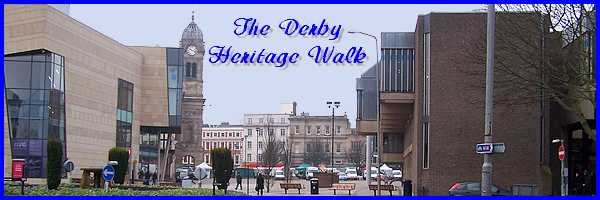
Our walk through Derby reached the Arboretum at the
end of the previous part and before we begin our own wander through
the trees it would be very remiss of me not to point you in the
direction of Christopher Harris' excellent website which is devoted
entirely to Derby
Arboretum. The Arboretum came about at the instigation of
Joseph Strutt in 1840 and I cannot hope to cover the history
of it in as much depth as Christopher has already done and nor
would I want too in a series such as this but I will include
some salient facts and seek out many of the significant trees
from the Tree Trail leaflet which is available from the Tourist
Information Centre at Derby Market Place.
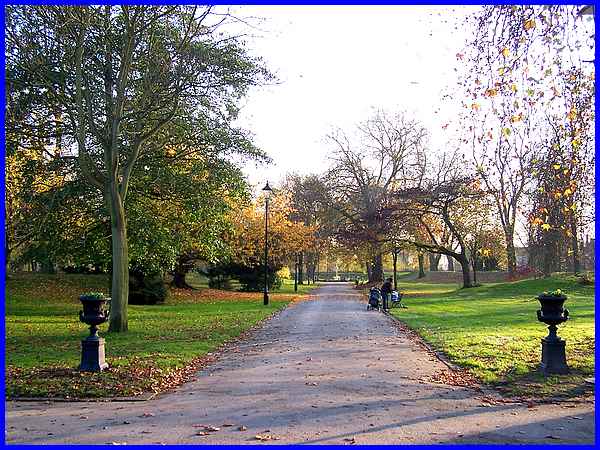
We'll begin with our back to Grove Lodge with this view along
a straight path to the fountain. A catalogue of trees in the
Arboretum was produced recently which splits it into five sections
(A, B, C, D & E) with each section containing trees from
the same family group. In this view Section E is to the left
of the path with Section A to the right. In this 23rd part of
the Heritage Walk, we will concentrate mainly on Section A.
|
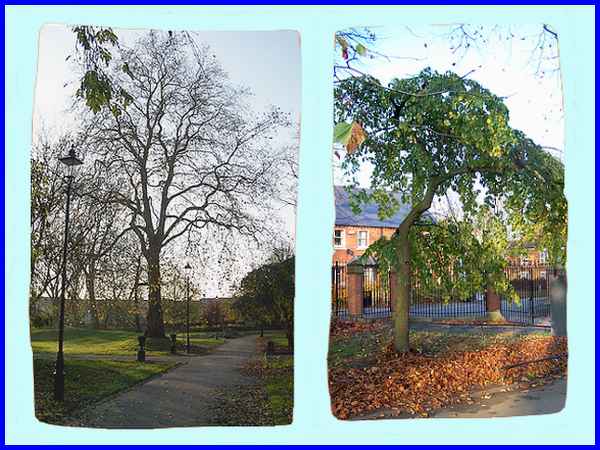
The first tree on the corner of the path in Section A is a large
example of a London Plane (above left). Despite its size, none
of the planes in the Arboretum are older than 130 years as they
were planted to replace trees that had died between 1840 when
the original plantings were done and 1860. The cause of the trees'
demise was disease, age or air pollution but the London plane
trees are resistant to air pollution and those planted in the
Arboretum thrived to such an extent that they threatened the
original concept of famous designer John Claudius Loudon. Loudon
had been recruited by local mill owner and philanthropist Joseph
Strutt who gave the site to the people of Derby and in the process
created not only England's but the world's first public park.
Another tree (above right) next to the entrance and opposite
the plane does not feature on the Tree Trail but is worthy of
note as it is an example of a "top graft", a practice
common in the 1800s but less frequently used nowadays. The catalogue
identifies it as a Camperdown Elm and shows that it was introduced
to the Arboretum about 1850.
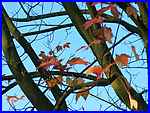  The next tree on the Trail also backs on to Grove
Street and although from a distance (left) it looked to have
shed all of its leaves, closer inspection (right) showed that
several of those still remaining displayed a distinctive red
tinge that helped (along with a label fixed to the trunk of course)
identify it as a Red Maple. It is not a common tree in this part
of the UK being more usually associated with its native environment
in America where it is responsible for many of New England's
"fall colours". The next tree on the Trail also backs on to Grove
Street and although from a distance (left) it looked to have
shed all of its leaves, closer inspection (right) showed that
several of those still remaining displayed a distinctive red
tinge that helped (along with a label fixed to the trunk of course)
identify it as a Red Maple. It is not a common tree in this part
of the UK being more usually associated with its native environment
in America where it is responsible for many of New England's
"fall colours".
|
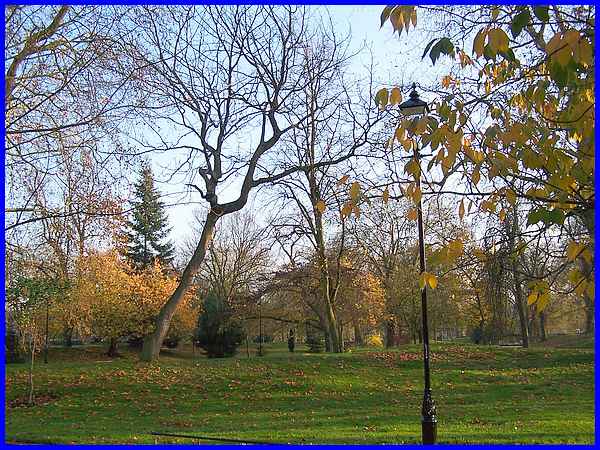
As we progress along the path parallel to Grove Street a tree
on the left growing at an angle belongs to the magnolia family
and because of its gherkin like fruits goes by the common name
of the Cucumber Tree. It is another tree of USA origin but was
introduced to the UK in 1736.
|
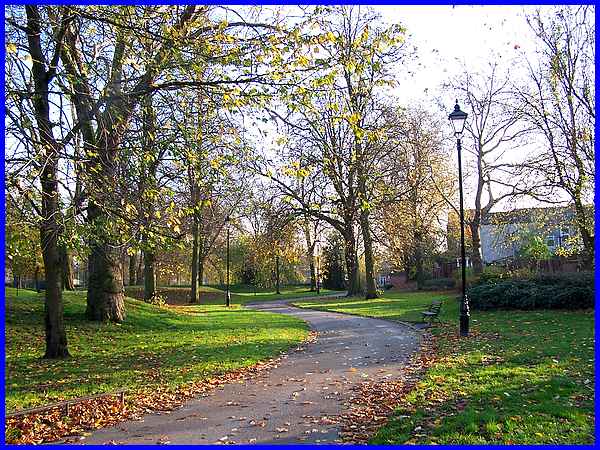
For an arboretum, Derby's is relatively small in size covering
a site of only some eleven acres but Loudon used several features
designed to make it appear to look bigger and concentrate the
eye within the confines of the site. One such feature was the
use of serpentine paths around much of the perimeter so that
the walker would experience an ever changing perspective.
|
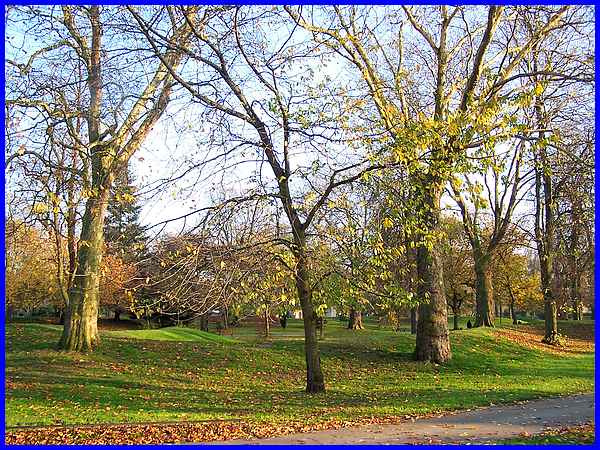
Another feature was the extensive use of mounds which served
a dual purpose. The first was to shield walkers on adjacent paths
from seeing each other thereby creating a feeling of quiet isolation.
This is not quite as true today as a certain amount of settlement
and an increase in the average height of the population over
170 years means that other people in the Arboretum can just be
seen over the tops of the mounds. The second purpose was to encourage
a view of the whole tree from the root bole up through the trunk
to the canopy. The tree in the foreground of the image above
is a Wild Cherry.
|
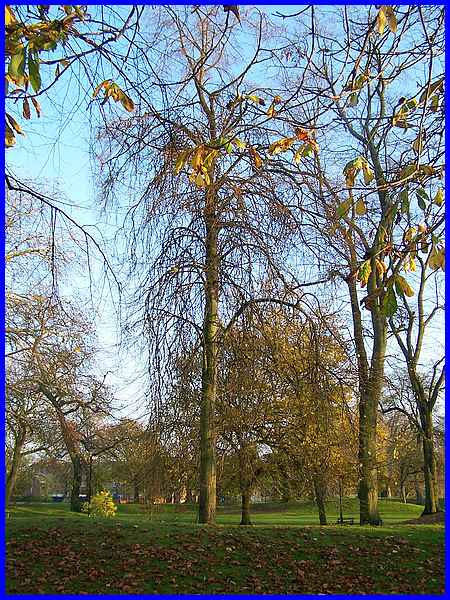
The final tree in Section A on the Tree Trail is a lime introduced
from the Caucasus about 1860 and is the tall upright one in the
centre of this image. In fact the specimens in Derby's Arboretum
are among the tallest in the UK. Naturally enough it goes by
the common name of the Caucasian Lime and has become popular
as a street tree in our cities as aphids do not feed on its leaves.
The Tree Trail leaflet continues however, "it has a weeping
growth habit which makes it unsuitable for street situations
as it requires regular pruning."
|
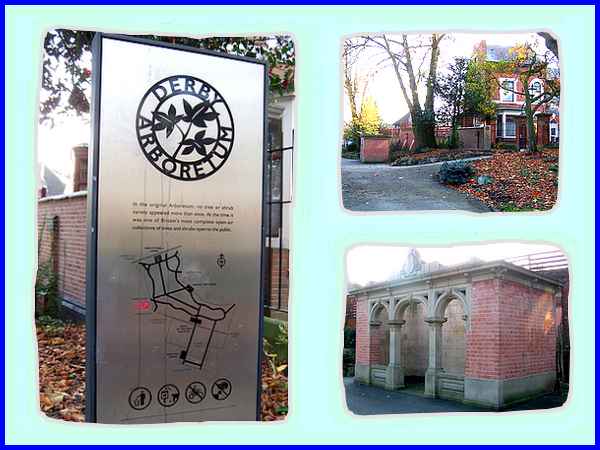
At each of the entrances to the Arboretum there is a panel (above
left) that includes a map and a "You Are Here" marker
and as we near the end of Section A the panel at the Harriet
Street entrance (top right) also proclaims "In the original
Arboretum, no tree or shrub variety appeared more than once.
At the time it was one of Britain's most complete open-air collections
of trees and shrubs open to the public." A similar panel
at Grove Lodge reads "Entrance to the Arboretum was originally
sixpence (thrupence for children), except for Wednesday and Sunday
afternoons, when it was free. Universal free entry was introduced
in 1882." Adjacent to the Harriet Street entrance is a "shelter"
(bottom right) although this one is a reproduction.
|
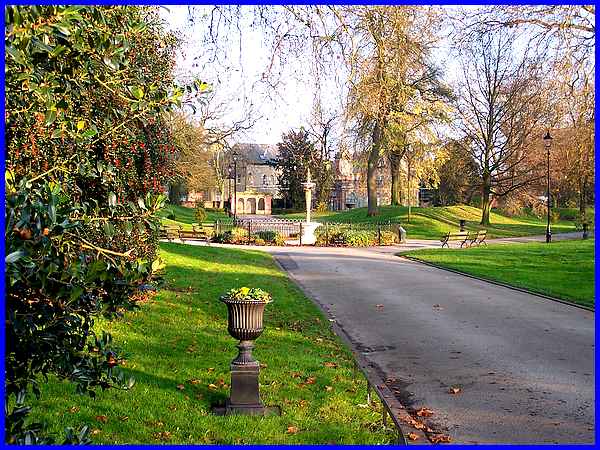
The shelter faces down a straight path that separates Section
A from Section B and leads to the fountain already seen from
Grove Lodge. Beyond the path continues between Sections D and
E to an identical shelter but this is an original. Both shelters
were another of Loudon's features to focus the eye within the
confines of the Arboretum as neither has nor never had a roof,
seats or windows so they are both "shelters" in name
only.
|

